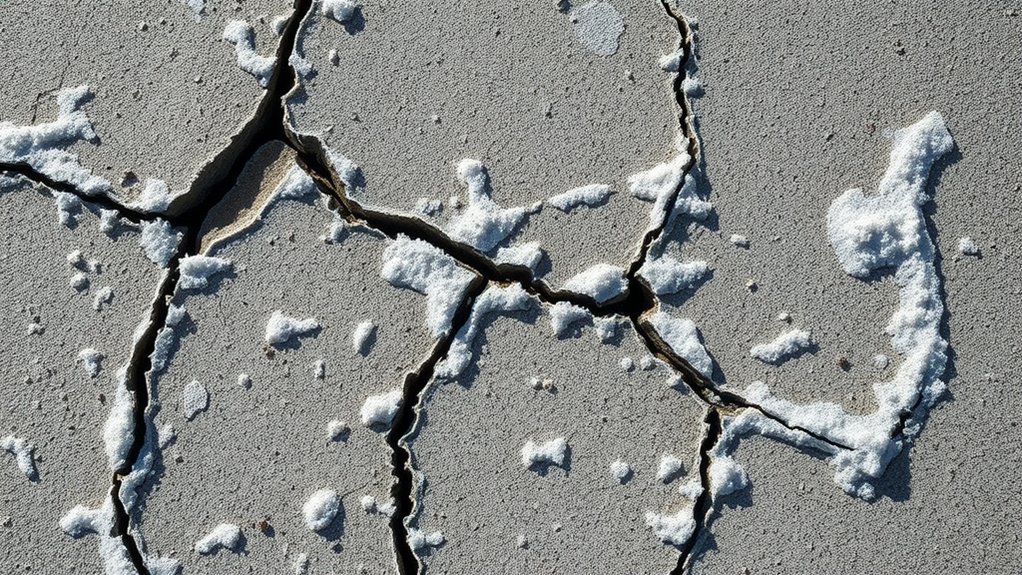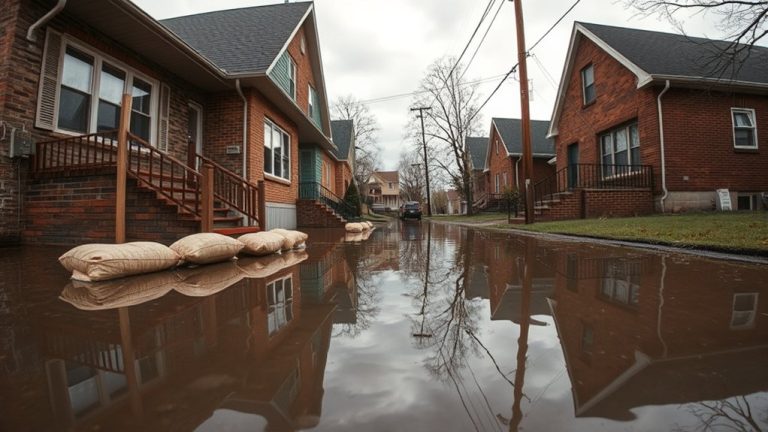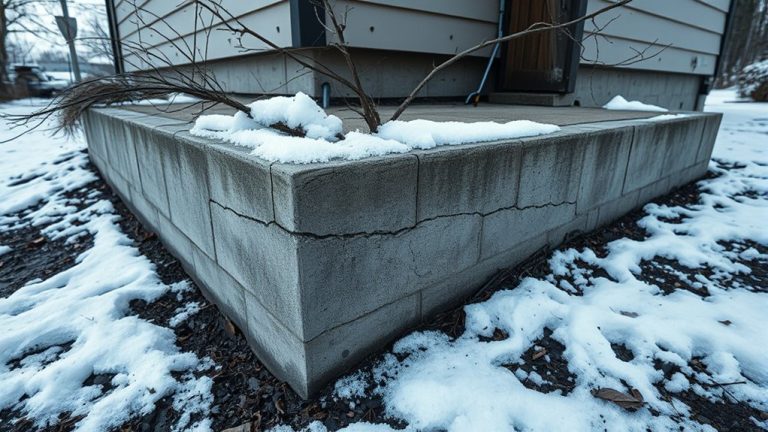Winter can wreak havoc on your home's foundation, turning harmless water into a destructive force. As temperatures drop and rise, moisture in the soil freezes and expands, creating novel pressure against your foundation walls. These unpredictable frost heaving patterns can cause serious structural damage that might go unnoticed until it's too late. Curious about how to protect your home's most critical structural element? Keep reading to discover the secrets of winter foundation defense.
Key Takeaways
- Freeze-thaw cycles cause water in soil to expand, creating pressure that pushes against foundation walls and generates small, progressive structural cracks.
- Moisture-rich soil around foundations becomes particularly dangerous during winter, as freezing temperatures can force ground expansion and create immense structural stress.
- Inadequate drainage systems increase foundation vulnerability by allowing water to accumulate near the base, which intensifies frost heaving and potential damage.
- Foundation weakening occurs gradually through repeated freeze-thaw cycles, with signs including cracked mortar lines, uneven floors, and hairline concrete fractures.
- Preventative measures like proper grading, extended downspouts, French drains, and strategic landscape design can significantly reduce winter's destructive impact on home foundations.
Understanding the Freeze-Thaw Cycle
When winter's temperatures dip below freezing, your home's foundation faces a hidden threat known as the freeze-thaw cycle. As water in the soil freezes and expands, it creates unpredictable frost heaving patterns that can push against your foundation walls. Small foundation cracks can develop and worsen during this process, potentially compromising your home's structural integrity. The soil's thermal conductivity plays an essential role in how quickly and dramatically these changes occur. You'll want to comprehend this process to protect your home. Each freeze-thaw cycle can gradually weaken your foundation's structural integrity, causing potential cracks and shifts.
Common Winter Foundation Vulnerability Zones
Winter's silent culprits can wreak havoc on your home's foundation, with certain areas proving more susceptible to damage than others. Your basement and perimeter walls are prime targets for frost heave prevention challenges.
Moisture-rich soil around your foundation can expand when frozen, creating immense pressure that pushes against concrete walls. Don't ignore exterior drainage slopes, which can channel water toward your foundation.
Crawl spaces and areas with poor insulation are especially vulnerable. By understanding these weak points, you'll be better equipped to protect your home's structural integrity against winter's destructive freeze-thaw cycles. Foundation waterproofing experts recommend proactive measures to prevent potential foundation damage during winter months.
Signs of Winter Foundation Damage
Foundation damage doesn't always announce itself with dramatic cracks or sudden collapses. Instead, it often sneaks up on homeowners through subtle warning signs that can indicate serious structural issues.
Here are three key indicators of winter foundation damage:
- Cracked mortar lines appearing around exterior walls
- Uneven floors or walls showing signs of settling soil
- Small hairline fractures in concrete or basement walls
These signs might seem minor, but they're your home's cry for help. Ignoring them can lead to expensive repairs and compromise your property's structural integrity, potentially threatening your sense of security and freedom.
Soil Moisture and Foundation Stress
Because soil moisture plays a critical role in foundation stability, homeowners need to understand how water can dramatically impact their home's structural integrity. Ground water fluctuations cause soil to expand and contract, creating tremendous pressure against foundation walls.
This movement can lead to significant soil erosion impact, weakening the ground supporting your home's base. When water saturates the soil around your foundation, it increases stress and potential cracking.
You'll want to monitor drainage, guarantee proper grading, and maintain consistent moisture levels to protect your home's foundation from winter's destructive freeze-thaw cycles.
Drainage Systems and Winter Protection
Proper drainage systems are your first line of defense against winter's harsh impact on your home's foundation. You'll want to protect your property from groundwater seepage control and potential frost heaving prevention by implementing strategic drainage solutions:
1. Install French drains around your foundation perimeter to redirect water away from vulnerable areas
Guarantee gutters and downspouts extend at least 5 feet from your home's base
Tilt your terrain to create a gentle slope that guides water from your foundation
Insulation Strategies for Foundation Defense
When winter's chill threatens to compromise your home's structural integrity, strategic insulation becomes a crucial shield against potential foundation damage.
You'll want to focus on insulation material selection that provides thorough thermal protection, such as foam board or spray foam insulation. Professional installation best practices recommend creating a continuous barrier around your foundation's perimeter. By sealing potential air gaps and choosing high-quality materials, you'll dramatically reduce the risk of frost heave and moisture penetration.
Your foundation deserves extensive protection against harsh winter conditions, and smart insulation is your first line of defense.
Professional Inspection and Maintenance Tips
Although homeowners often overlook foundation maintenance, regular professional inspections can save you thousands in potential repair costs. A thorough assessment by a qualified expert can detect early warning signs of winter-related damage before they become expensive problems.
Key maintenance tips include:
- Schedule annual foundation inspections during fall to prepare for freezing temperatures
- Have professionals check for existing cracks, drainage issues, and soil moisture levels
- Implement recommended routine checkups to track your foundation's long-term health
Your proactive approach can protect your home's structural integrity and prevent costly future repairs.
Cost-Effective Winter Foundation Preservation Techniques
How can homeowners effectively protect their foundation without breaking the bank during harsh winter months? Your seasonal evaluation schedule is essential for foundation preparation measures.
Start by checking your property's drainage and ensuring gutters are clean and positioned to direct water away from your foundation. Seal any visible cracks with affordable weatherproof caulking, and consider adding insulating mulch around your home's perimeter. These preventative steps can drastically reduce potential freeze-related damage.
Frequently Asked Questions
Can Foundation Damage From Winter Freezing Be Covered by Homeowners Insurance?
Your insurance might cover foundation damage from winter freezing, but check your policy's coverage limits and be aware that DIY repairs could void your claim, leaving you financially vulnerable.
How Quickly Can Winter Freeze Damage Worsen a Home's Foundation?
You'll see frost heaving patterns escalate foundation damage rapidly, with each thaw-freeze cycle potentially widening cracks within weeks, threatening your home's structural integrity and your freedom from costly repairs.
Are Older Homes More Susceptible to Winter Foundation Freeze Damage?
You'll find older homes are more vulnerable due to weaker foundational materials and less advanced insulation. Implement strategic freeze prevention strategies to protect your home's structural integrity and maintain its independence.
What Temperature Range Is Most Dangerous for Foundation Structural Integrity?
Freeze thaw cycles between 20°F and 32°F pose the greatest risk, causing ground heaving patterns that'll stress your foundation's structural integrity and potentially create long-lasting damage to your property's base.
Can DIY Repairs Effectively Solve Winter-Related Foundation Damage Issues?
DIY repairs can help, but they're risky. You'll want professional inspections to identify serious damage. Cost-effective repairs work best when caught early, ensuring your foundation's integrity without breaking the bank.



